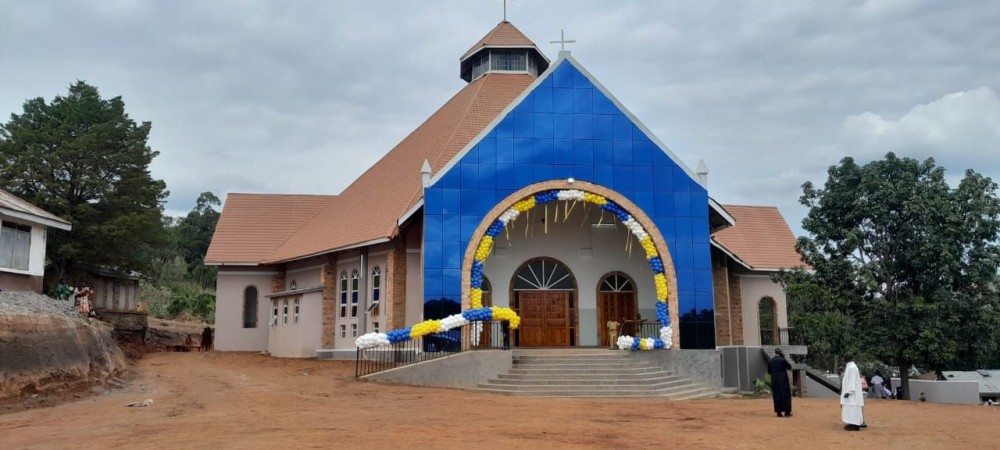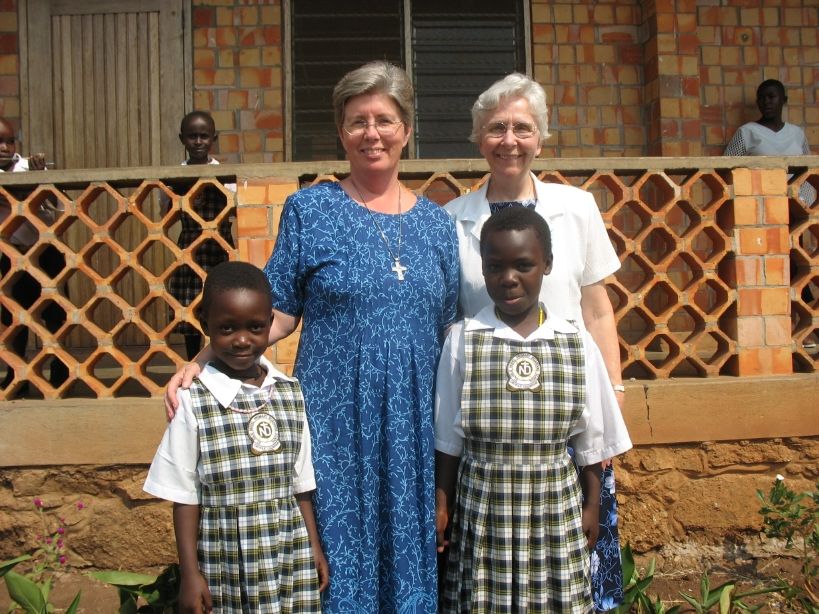
PROSPECT HEIGHTS — As a member of the Sisters of Notre Dame of the United States, Sister Colette Theobald said she spent some of the best years of her life serving with her congregation in Uganda from 2015 to 2022.
“I think I got much more from them than they got from me,” Sister Colette said of the people she met during her seven years in the East African country. “One of the things that I admire so much is their sense of hospitality.
“In this little village, people are living in mud huts with grass roofs, and they’ll invite you into their home, and they’re so happy to have you come.”
The sisters not only established the St. Julie Primary Boarding School in Buseesa, an impoverished area of Uganda, but they also helped a local pastor get a parish built to commemorate the Uganda Martyrs, a group of 22 Catholic converts who were slain over a two-year period, from 1885-1887, because of their religious beliefs.
The sisters assisted the pastor, Father Godfrey Tuhairwe, in his fundraising efforts by arranging a visit for him to their mission in the Archdiocese of Los Angeles so he could speak at churches and solicit donations. The sisters also rolled up their sleeves and helped clear dirt, rocks, and debris from the land where the parish was eventually built.
This year marks the 60th Anniversary of the canonization of the Uganda Martyrs, and the anniversary has folks like Sister Colette reminiscing bout their time there.
“There are reminders all around you of the martyrs,” said Sister Colette, who served as principal of St. Julie Primary Boarding School.
“My own sense of the influence of the Uganda Martyrs is that the faith is worth dying for and that they went with joy to show how much their faith meant to them,” she said. “That has inspired generations ever since.”
The Uganda Martyrs, also known as St. Charles Lwanga and Companions, were named after a page (servant) in the royal court who died rather than renouncing Catholicism. The martyrs were said to have shown great courage in the face of death, even praying and singing hymns as their tormentors lighted the fires that burned them alive.
Their death sentences came by order of the country’s ruler, Mwanga II, the king of Buganda, and took place at the time when Catholicism was starting to take hold in Uganda. Mwanga II, who ruled from 1884-1897, is said to have feared losing his influence as the supreme leader of the kingdom if large numbers of his subjects turned to Jesus Christ as their savior.
King Mwanga’s father had a much more welcoming attitude toward religion. In 1879, a group of priests known as the White Fathers came to Buganda to work as missionaries and were positively received by King Muteesa. However, following the king’s death in 1884, his son Mwanga II took the throne, reversed his father’s positions, and began engaging in religious persecution.
Charles Lwanga, born in 1860, was a page in the royal court. He was baptized into the Catholic faith in 1885 and then evangelized and baptized others. He was put to death at the stake in 1886 under Mwanga II.
During the two-year period from 1885-1887, the Uganda Martyrs, which also included 23 Anglicans in addition to the 22 Catholics, were killed in small groups. They were all either burned alive or beheaded.
Many of the martyrs were burned at the stake in what is now the city of Namugongo, where a basilica dedicated to their memory now stands.

In the late 19th century, there were calls in Uganda and elsewhere in Africa for the 22 Catholic martyrs to be declared saints. The martyrs were beatified by Pope Benedict XV in 1920, and 44 years later, Pope Paul VI canonized them. The Uganda Martyrs Feast Day is celebrated on June 3.
Construction began on the Basilica of the Uganda Martyrs in Namugongo in 1965 and was dedicated three years later. Over the years, it has become the destination of pilgrimages, drawing millions of the faithful eager to celebrate the feast day.
Sister Colette, who now serves the Sisters of Notre Dame in Ventura, California, remembered the excitement in the country in the days leading up to the feast day. She would see people on the pilgrimage to the basilica, making their way to Namugongo on foot.
“A couple of weeks before … you start seeing people walking on these roads in groups, and they’re singing as they’re walking,” she recalled. “We would hear from our sisters in Tanzania, Kenya, and Mozambique that people in those countries had also set out for the pilgrimage.”
According to the Vatican News, an estimated 3.5 million people took part in the pilgrimage in 2024. The journey can take some pilgrims up to two weeks to complete, with many pilgrims sleeping in churches and schools along the way and carrying provisions to allow them to cook.
According to the U.S. State Department, 39% of the 46.2 million people living in Uganda today are Catholic.
“Their faith as a people is beautiful,” Sister Colette explained. “They sing, they dance for hours on end because it’s just so meaningful to them.”
